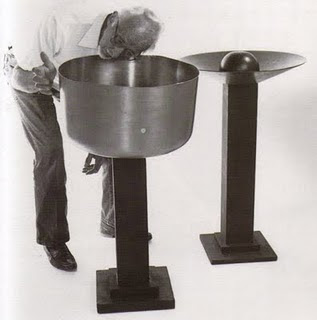Some guy named Ramon Galvan has a blog named Outer Tumbolia. I looked through the blog for a while, and I must say that I do not get the blog's theme or direction. Maybe he is writing articles about sound.
Anyway, the blog includes an interesting article about how Reinhold Marxhausen began to make sculptures that make sounds. Whenever I visited Marxhausen's studio, he would show me some sound-making sculpture he was developing.
The relevant part of the blog article follows:

Reinhold Marxhausen grew up in the 1920's and 1930's, the son of a pastor and one of eight children in Vergas Minnesota. He played the musical saw, he played water-tuned bottles, and he found piano lessons boring. He carried stardust in his pocket.
After military service, followed by degrees in art and biology, Marxhausen took a teaching position at Concordia College in Seward Nebraska, where he remained until his retirement in 1990.
It was in 1962 that he first began to work with sound objects. "It was a boring Saturday at the sculpture studio; no plans for the day," he recalls. "I found a door knob on the table and welded some wires on one end just for the fun of it. I placed the door knob to my ear and strummed the wire on the opposite end."
"WOW."
Since his discovery, Marx has made a wide variety of sound sculptural forms, and he has developed the door-knob idea in two main directions. One form consists of objects with exposed, external spines. some of the most successful have been his manual walkmans, (below) made like a pair of headphones, with spines sticking out from the metal ear pieces and sometimes rising from the over-the-head connecting piece. They make a stereo concert of lovely sounds, on a minuscule one person scale.
The other form is a small, chunky, metal object, fully enclosed, with no hint of what is inside. Sound comes from within when you shake or rock it, audible only when you hold it close to your ear. What is in there? Marx is not telling.
The objects are just pocket-sized and, recalling the meteor of his childhood, Marxhausen has given them the name Stardust. He makes them as plain in appearance as can be; they look like worn and dirty stones. There's a Marxhausen message in his having put so lovely a sound in such a homely thing.


No comments:
Post a Comment